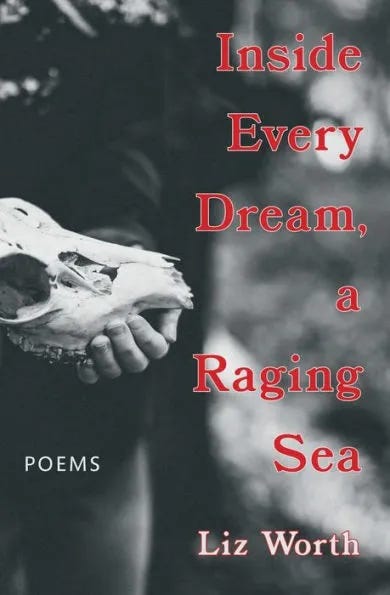Author Interview Series: Inside Every Dream, A Raging Sea by Liz Worth
Poetry, Spells, and Tarot
A few semesters ago, I taught Liz Worth’s poetry collection The Truth is Told Better This Way. If I wasn’t already a fan of her work, I was even more so after I finished teaching it and talking about witchcraft and poetry as spellwork. When I got the opportunity to read an advanced copy of her upcoming collection Inside Every Dream, A Raging Sea, it was an easy ‘yes!’ for me, and if we’re being honest with each other, I tore through it with reckless abandon, taking lots of notes, highlighting lines, and nodding with my head and heart as I shared in the experiences on the page.
Book summary:
“Our lives are full of personal legend. Trivial details can feel fated, weighted with meaning. What happens when we start to see the words we speak as spells? Where do the lines of ritual, magic, and daily life blur? Inside Every Dream, a Raging Sea elevates the every day, celebrating memory as individual folklore. These poems offer a way into the interconnected elements of our lives and the world around us, embodying the state of possibility and openness we are all searching for.
Inspired by Worth’s professional tarot reading, these poems explore the thin veil between them and suggest it barely exists at all.”
Below is a short blurb about her work, and then Liz graciously agreed to an interview with me about her collection, her process, and of course, ghosts and tarot. I hope you enjoy the conversation and will consider picking up copy of her collection soon. Remember, preorders and reviews are two of the best ways to support the authors you love!
Praise for Inside Every Dream, a Raging Sea
“‘My first prophecy was a poem,’ writes Liz Worth, conjuring the self in a state where the past portends an uncertain future. At this crossroads, personal experience informs universal truth, and Inside Every Dream, a Raging Sea unfolds like a spell cast to blur the line between legerdemain and the slow burn of daily life. A haunting, illusory read.” —Jim Johnstone, author of The King of Terrors
SW: Hi Liz! Welcome to my author series which I affectionately call The Madhouse. Since this is your first time joining us here, can you tell us a little bit about yourself and what drew you to poetry in the first place?
LW: Hi Stephanie! Thank you so much for inviting me here.
I was always interested in all kinds of writing. I like playing with language and I enjoy how flexible writing is. It doesn’t take a lot to make an idea tangible in this medium, so it feels exciting to write. You can have an interesting dream or overhear an odd conversation and turn it into inspiration for a story or poem or book and all it takes is yourself.
Poetry was always interesting to me even when I was a child. I don’t know why that is. Maybe I’m an old soul, but when I was young I was often drawn to the poetry section in the library and to the idea of being a poet. I was attracted to poets who write from a place of myth and mystery. Gwendolyn MacEwen’s book Magical Animals was one collection that really fascinated me as a kid. I was also interested in Edgar Allan Poe early on.
I was a teenager in the ‘90s and zine culture was huge back then, and that influenced me a lot, too. I started hanging out downtown in shops that sold zines and a lot of zine creators were publishing anything they wanted, including poetry. That gave me the idea that I could publish my own writing, too, and so I started to write vampire-inspired poetry (I was really into vampires and goth culture at the time) and made my own zines to get that work out. I wasn’t a great poet then, but making my zine helped me connect to other writers and from there I just kept focusing on my path as a poet.
SW: What was your writing process like while writing Inside Every Dream, A Raging Sea? When did the idea for the collection take shape?
LW: My process for this book was the same for a lot of the poetry I’ve written. I don’t force it, it just happens. A lot of my writing comes to me when I’m walking down the street. I’ll get an idea for an image, or a word or phrase will stick in my mind, and I’ll make note of it and then build something around it later.
With this book, I didn’t even notice that this was becoming a collection. I felt like my writing had slowed. One day I was reviewing the notebook I had on the go and realized that I’d been more consistent than I expected. When I read back the pieces I’d been working on for the better part of two years I realized I had a collection on my hands.
SW: While reading this collection, I noticed a lot of elemental personification and allusion. For instance, in your poem “Maybe, Sometimes” there are lines like “it was full of sand and grated the tips of my fingers,” and “Thunderclap, my pulse/ a wave against a rock” and “What shape would I take/ if I were thrust into the sky?/ I am not a crescent moon.” Can you talk a little about how nature, seasons, or even cycles play a part in your creative work? And do you ever feel inspired to write at specific times, i.e. the New Moon, during storms, etc.
LW: Nature, seasons, and cycles are all part of my everyday thinking. I’ve studied astrology for many years and am always following the cycles of the moon, or paying attention to the positions of the planets and the mythology and archetypes those placements can inspire. I do sometimes like to set aside time around new moons to write or create, but creativity doesn’t always happen on command and so I try not to be too rigid with this.
Since 2015 I’ve been reading tarot professionally and so cycles show up there, too. One thing that I do in this line of work is help people understand the timing of their own lives. Sometimes we are in periods where things are flowing and there is a lot of momentum around what we’re doing. Other times life is still or stagnant.
Our experiences don’t move in a straight line, as much as we might want them to at times. And so a lot of my poetry ends up reflecting these things – how we are a part of nature’s cycles, and within that, we have our own timelines to reconcile.
SW: Your poetry is so bewitchingly beautiful and I’ve been a fan since reading your collection The Truth is Told Better This Way. In what ways do you find poetry and spellwork similar?
LW: Thank you so much.
Spells are incantations. They hold a rhythm to them the way poetry does. A spell is created to be memorized so that you can repeat it as needed. Some poetry is crafted similarly.
I’ve always liked to play around with the idea of poetry and spells being interchangeable. Magic and the occult have been a part of my life for a long time. I can’t help but be inspired by something that is so varied and historied.
When I was in my early 30s I had a performance art project called Salt Circle and we would experiment with creating poems that could also be performed as small rituals on stage. I think that’s also where poetry and spellwork intersect. When we take our work off the page and deliver it to an audience, we are casting a spell within that moment. I like to take that idea literally sometimes, whether it’s through a performance piece or the written word.
SW: So much of this collection is about grief, regret, and the hauntings that follow us throughout our lifetime. There is in a line in your poem “Memory of Place” that reads “I write this from the edge of my teeth.” Do you find writing poetry to be a catharsis when it comes to dealing with pain? If so, can you talk a little about the role it plays in your mental health (if you’re comfortable with that).
LW: I do have a lot of regret. I often hear people say that they wouldn’t change a thing about their lives, but if I could go back in time I’d probably do everything differently! It’s hard not to go through life without making decisions you wish you could take back. And you get older and more mature, you start to understand the ways you’ve hurt other people along the way. Even if you didn’t always intend to at the time.
I don’t know that writing gives me a lot of catharsis, to be honest. But I have always wanted to write honestly, no matter what style or genre I’m writing in. Because I think that writing is an incredibly powerful way for us to relate to each other. And so when I write from an honest place, I know that there is a good chance that there’s reader out there who is going to see themselves in my words. Even if our experiences are different.
And that’s what’s important to me, is that we communicate in ways that make each other feel less alone. Sometimes when you are in conversation with other people, it’s hard to speak your truth, especially if the person you are talking to doesn’t understand, or can’t relate, or won’t listen. But when you put your truth on paper, no on can take that away from you. It’s out there now, made concrete, and that is a powerful thing to feel.
SW: In your poem “The ride home is never quick” you write “People around here say they have other types of ghosts—the ones that live in your house and/ breathe down your neck.” Something I love about your work is how it straddles literary and genre. In my classes, I talk about how that line is often blurred, and I’m curious about your take on that specifically with your work. And more than anything, what I really want to know is if you believe in ghosts and if so, if you’ve ever had an experience with one.
LW: I’m not consciously trying to straddle literary and genre in my work, or force styles to blur together. It’s just how the writing comes out. I take influence from so many sources that it all blurs into one, I think.
I love the experimentation of William S. Burrough and Kathy Acker, I also love the sprawling, detailed, sexual worlds of Anne Rice. I love multi-disciplinary poets like Lydia Lunch who also straddle genres and styles.
And music and subcultures play a huge role in in my identity and in my writing.
But when I list these reference points, I’m looking at names and movements that have been successful, though not always commercially so. And maybe that’s part of blurring that line. When you take influence from people and things that were never conventional, or that set the tone rather than towed the line, then you might not be paying attention to the typical rules of writing and so your work comes out reflecting that.
In terms of ghosts, of course I’ve had experiences with ghosts. I grew up believing in ghosts because my mother had lived in a haunted house at one point and always stuck to her story. A friend of mine had a ghost in his apartment once, which I heard running down the stairs, and my husband and I saw the spirit of an old woman in our last apartment.
So yes, ghosts are out there. They might even be the people we pass by on the streets sometimes. Who knows? Life is strange and there’s often more than meets the eye to this existence.
SW: What poets are you currently reading? Are there any collections you’re looking forward to adding to your TBR list?
LW: Lately I’ve been revisiting the work of Peter Dubé and his book Conjure: A Book of Spells. This work is an excellent exploration of the parallels between poetry and spellwriting.
I’m also looking forward to Jessica Bebenek’s No One Knows Us There, which is coming out through Book*hug in 2025.
SW: What’s next for your readers?
LW: I just finished the first draft of a novel about two roommates who end up opening portals in their apartments. Like anything in progress, I don’t know exactly what it will become, but I am hoping it comes together the way I see it in my imagination.
SW: Bonus question: Do you ever use tarot to help you write poetry?
LW: I do sometimes use tarot for writing, mostly to get something started. I usually work from the image itself rather than the guidebook meaning. For me tarot is less about “what does this card mean” and more about “what is this card showing me.” Every card in tarot is active in some way: The images are depicting motions and states and scenarios, so tarot can give us verbs and nouns and adjectives that can become jumping-off points for writing.
Bio: Liz Worth is a poet, novelist and nonfiction writer. She is a two-time nominee for the ReLit Award for Poetry for her books The Truth is Told Better This Way and No Work Finished Here: Rewriting Andy Warhol. Her first book, Treat Me Like Dirt, was the first of its kind to provide an in-depth history of southern Ontario’s first wave punk movement. Her other works also include Amphetamine Heart, PostApoc, and The Mouth is a Coven. Her writing has appeared in Chatelaine, FLARE, Prism, The Globe and Mail, Toronto Star, and Broken Pencil, among others. Liz is a professional tarot reader and lives in Hamilton, Ontario.
Pre-order link:
https://bookhugpress.ca/shop/author/liz-worth/inside-every-dream-a-raging-sea-by-liz-worth/
Author website: www.lizworthauthor.com
Instagram: @lizworthtarot and @80spodcast






